XuLA/XuLA2
http://www.xess.com/prods/prod048.php XuLA
http://www.xess.com/prods/prod055.php XuLA2

http://www.xess.com/manuals/XuLA-manual.pdf


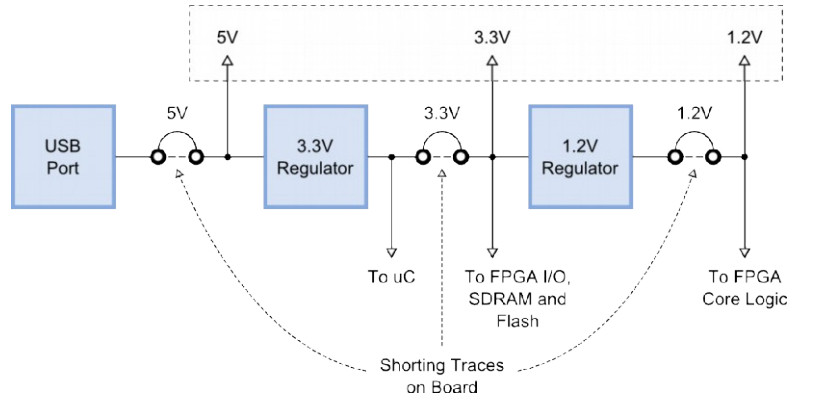
FPGA
The programmable logic device on the XuLA Board is either a XILINX 200,000-gate
XC3S200A Spartan 3A FPGA in a 100-pin VQFP, or a 50,000-gate XC3S50A.
Microcontroller
The XuLA Board uses a Microchip 18F14K50 PIC to perform the following functions:
Reset & initialization: Upon power-up or assertion of the reset, the microcontroller
initiates the configuration of the FPGA from the Flash and holds the FPGA in its
cleared state if the configuration fails. It instantiates its USB endpoints and
participates in the USB enumeration process.
Clock generation: The microcontroller uses its pulse-width modulation (PWM) circuitry
to generate a 12 MHz square-wave that enters one of the FPGA's global clock
inputs.
USB-to-JTAG communication: The microcontroller accepts configuration bitstreams and
data as packets over the USB link and transforms these into a sequence of
transitions upon the FPGA's JTAG pins. It also receives data from the FPGA
through the JTAG port which it bundles into packets for return through the USB
link.
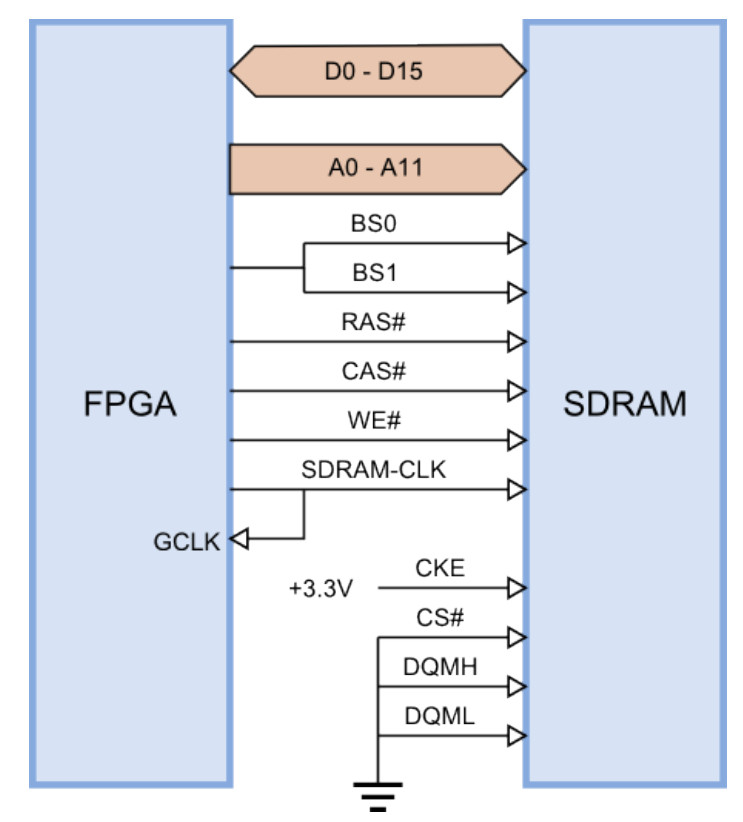
SDRAM
The XuLA Board incorporates an 8M x 16 SDRAM (Winbond W9812G6JH) that connects to
the FPGA as shown below. To compensate for circuit delays, the clock signal to the
SDRAM is re-routed back to a global clock input so the FPGA can synchronize itself with
the SDRAM.
Because of the limited number of pins provided by the FPGA's package, the following
modifications were made to the SDRAM interface:
The chip-select (CS#) is tied low so the SDRAM is always enabled.
The clock-enable (CKE) is tied high so the SDRAM always requires a clock signal in
order to keep its data refreshed.
Both data qualifier mask enables (DQMH and DQML) are tied low to disable byte-wide
access to the SDRAM, so all operations involve the entire sixteen-bit data width.
A single FPGA pin drives both bank-select inputs (BS0 and BS1). This reduces the
accessible region of the SDRAM by half to 4M x 16.
Flash
The XuLA Board has a 2-Mbit SPI Flash (Winbond W25X20BV) that connects to the FPGA
as shown below.
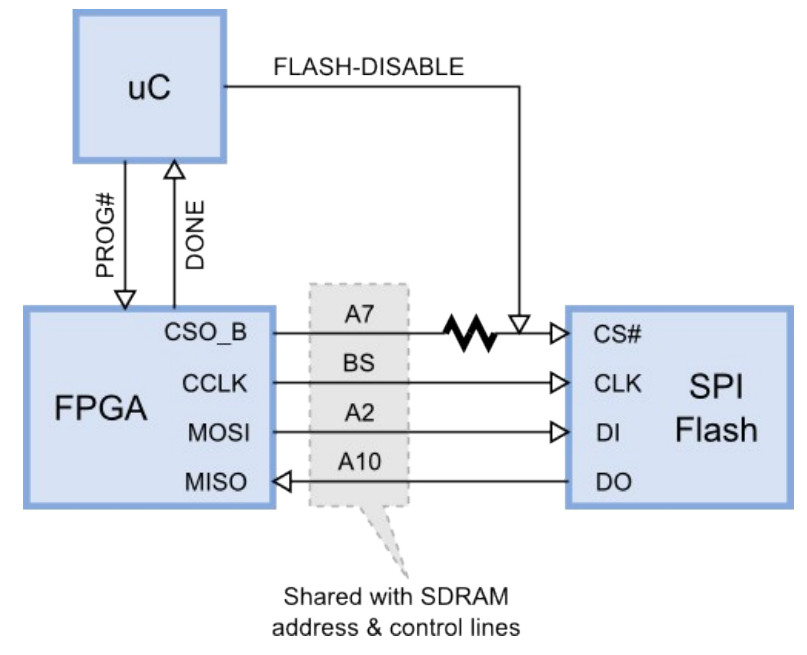
Due to the limited I/O of the FPGA package, the Flash and SDRAM chips share some of
the FPGA pins. In combination with the SDRAM being permanently enabled (its chip-select
is always asserted), this means that the Flash and SDRAM cannot be used simultaneously.
Therefore, the following events occur when the XuLA Board comes on:
1. The microcontroller puts its FLASH-DISABLE output into a high impedance state and
pulses the FPGA's PROG# pin to initiate the configuration from the Flash.
2. The FPGA lowers its CSO_B pin to enable the Flash, and then uses its CCLK, MOSI and
MISO pins to read the stored bitstream. Because the SDRAM is not active during the
FPGA's configuration (SDRAM-CLK is inactive since the FPGA is not configured), it
doesn't matter if the SDRAM address and control pins are toggling.
3. Once the Flash delivers its bitstream, the FPGA's DONE pin is asserted. The
microcontroller senses this and drives its output pin high to de-assert the FLASHDISABLE signal,
thus turning the Flash off. The FPGA can't access the Flash any more,
but it can access the SDRAM without affecting the Flash.
It is possible to set a flag that prevents the microcontroller from disabling the Flash after
the FPGA is configured (as described here). Then the logic design loaded into the FPGA
can access the Flash, but it can no longer use the SDRAM (the toggling of the SDRAM
address and control pins might inadvertently corrupt the Flash contents).
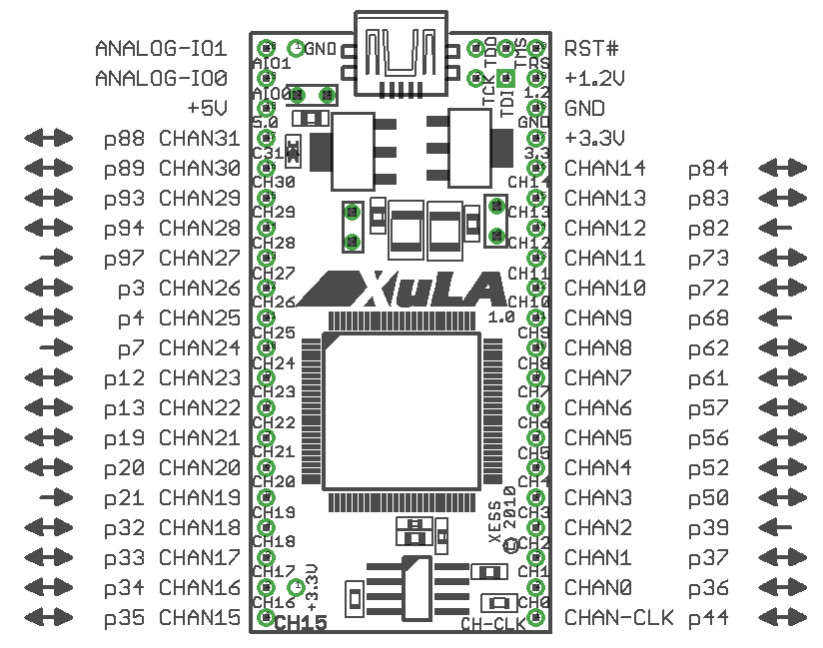
5V Tolerance Issues
The CHAN* and CHAN-CLK pins connect directly to the pins of the FPGA which typically
use an I/O voltage of 3.3V. When driving the inputs of external 5V logic, you should check
that their VIH threshold is less than the VOH of the XuLA outputs. (This is true for most 5V
logic families.)
You must also take care not to exceed the input voltage rating of the FPGA pins when
they are driven by external 5V logic outputs. A common technique for protecting the
Xilinx FPGA pins is shown below. When presented with a voltage greater than 3.3V + 0.7V
= 4.0V, the protection diode built into the FPGA pin's circuitry conducts current and the
excess voltage is dropped across the 100Ω resistor. This keeps the voltage directly on the
FPGA pin from ever exceeding 4V, which is within tolerated limits. The resistor value
should be set so the current through the protection diode does not exceed 10 mA.
However, by default, the Xilinx Spartan-3A FPGA disables the protection diodes.
In order to enable these diodes, you can place the following text into your Xilinx ISE
project constraint file for every I/O pin that will be connected to 5V logic:
NET "input_name" IOSTANDARD = PCI66_3;

http://www.xess.com/manuals/XuLA2-manual.pdf
XuLA2 is an open-source FPGA development board, based on Xilinx Spartan-6 LX25 low cost FPGA.
The design provides 32MB SDRAM, micro-SD card slot, two voltage regulators, supervisory circuitry
based on PIC 18F14K50 microcontroller and USB port for programming the FPGA.



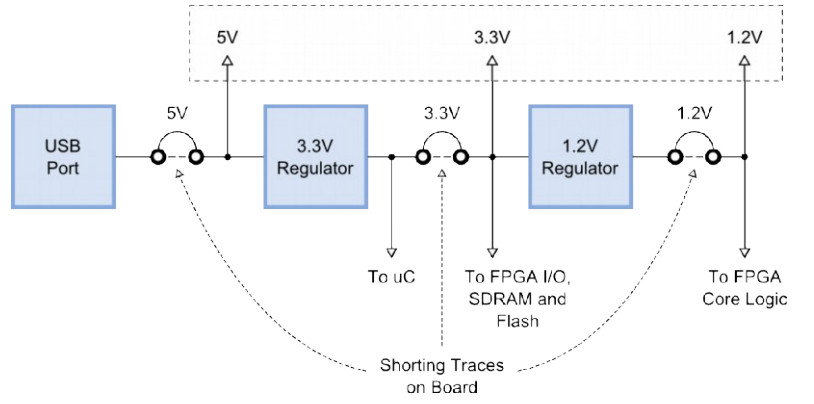
FPGA
The programmable logic device on the XuLA2 is a XILINX XC6SLX25 Spartan 6 FPGA in a
256-ball BGA package (FT256).
Microcontroller
The XuLA2 uses a Microchip 18F14K50 PIC to perform the following functions:
Reset & initialization: Upon power-up or assertion of the reset, the microcontroller
initiates the configuration of the FPGA from the SPI Flash and holds the FPGA in
its cleared state if the configuration fails. It instantiates its USB endpoints and
participates in the USB enumeration process.
Clock generation: The microcontroller uses its pulse-width modulation (PWM) circuitry
to generate a 12 MHz square-wave that enters one of the FPGA's global clock
inputs.
USB-to-JTAG communication: The microcontroller accepts configuration bitstreams and
data as packets over the USB link and transforms these into a sequence of
transitions upon the FPGA's JTAG pins. It also receives data from the FPGA
through the JTAG port which it bundles into packets for return through the USB
link.
SDRAM
The XuLA2 incorporates a 16M x 16 SDRAM (Winbond W9825G6JH) that connects to the
FPGA as shown below. To compensate for circuit delays, the clock signal to the SDRAM is
re-routed back to a global clock input so the FPGA can synchronize itself with the SDRAM.
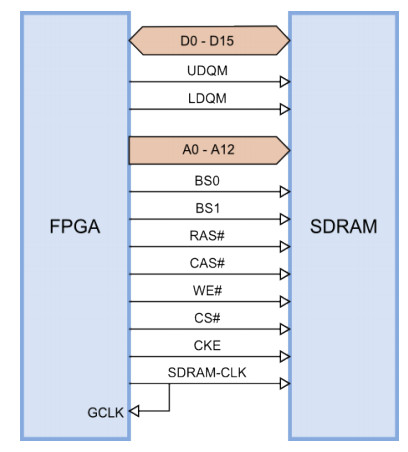
SPI Flash and microSD Card
The XuLA2 has an 8-Mbit SPI Flash (Winbond W25Q80BV) and a microSD card socket that
connect to the FPGA as shown below. During FPGA configuration, the bitstream is read
from the SPI flash while the microSD card is disabled. After configuration, either the SPI
Flash or the microSD card can be accessed by lowering their respective chip-selects and
performing SPI read/write operations.
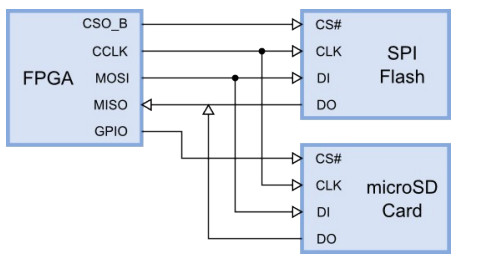
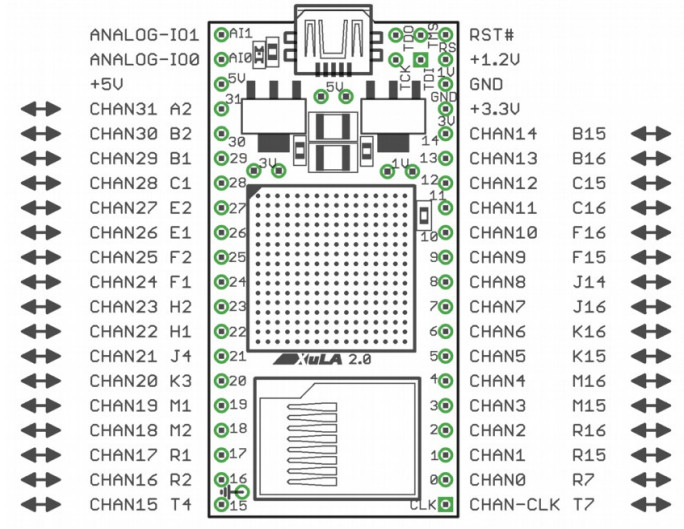
XuLA/XuLA2的更多相关文章
- Unity3D|-XLua热更新用法的大致流程
xlua是由腾讯维护的一个开源项目,我们可以在github上下载这个开源项目并查看一些相关文档 官网:https://github.com/Tencent/xLua 配置文档:https://gith ...
- miniSpartan6, another Spartan 6 Kit
http://thehardwarer.com/2013/05/minispartan-6-another-spartan-6-kit/ miniSpartan6 is an Opens Source ...
随机推荐
- 微信access_token和refresh_token保存于redis
简介 通常理解的access_token和refresh_token access_token是用来对客户端进行认证的,类似与密码,有一定的有效期.当过期后可使用refresh_token重新获取一个 ...
- acm专题---dfs+bfs
题目来源:http://hihocoder.com/problemset/problem/1049 #1049 : 后序遍历 时间限制:10000ms 单点时限:1000ms 内存限制:256MB 描 ...
- css如何将div画成三角形
首先了解一下盒模型: 盒模型 先看一段代码: #div1{ height: 100px; border-style: solid; border-width: 100px 100px 100px 10 ...
- 推荐一个数据相关的网站tushare
推荐一个网站:tushare 使用方法如下: pip install tushare 我是使用pycharm直接安装的 抓取了浦发和光大的股票数据,并通过csv进行保存,和通过plt进行图片打印 im ...
- Jmeter----5.1 设置中文
注意:JMeter5需要Java8 以上,本文环境是Win7 64位 设置永久默认汉化:在Jmeter的安装目录下的bin目录中找到 jmeter.properties这个文件,用文本编辑器打开.在# ...
- Saltstack 介绍、安装、配置语法(一)
Slatstack 介绍 官网:https://saltstack.com/ 官方源:http://repo.saltstack.com/ (介绍各操作系统安装方法) yum install htt ...
- MVC Partial页面的使用
先建立Action: public PartialViewResult CurrentCount() { ViewBag.Count = CurrentUserCount; return Partia ...
- CodeFoorces 803C Maximal GCD
枚举. 枚举$gcd$,然后计算剩下的那个数能不能分成$k$个递增的数. #include <iostream> #include <cstdio> #include < ...
- Python函数-闭包的概念
一个函数和它的环境变量合在一起,就构成了一个闭包(closure).在Python中,所谓的闭包是一个包含有环境变量取值的函数对象.环境变量取值被保存在函数对象的__closure__属性中.比如下面 ...
- 【JAVAWEB学习笔记】11_XML
今日内容介绍 编写服务器软件,访问指定配置内容 访问tomcat下已经发布的web项目 今日内容学习目标 可以编写xml存放任意内容 通过DTD约束编写指定格式的XML 通过Schema约束编写指定格 ...
